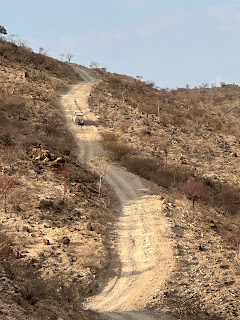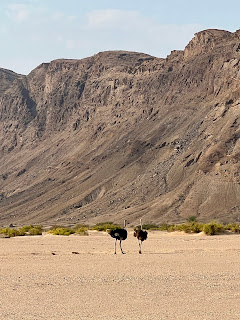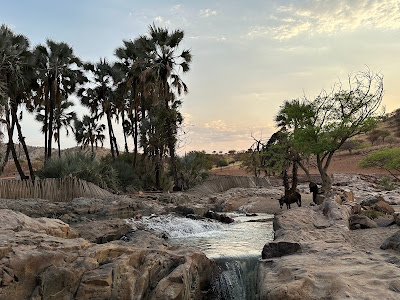 |
| On the way to the top of Rooidrum Pass, Namibia, 2024. |
"Below, I recount the thrilling story of what turned out to be our wildest 4WD experience in Namibia to date. We were pushed to the limit, and it became a very long day, requiring a major detour through desolate desert landscapes, navigating some of Namibia’s toughest passes, including Rooidrum and Joubert's Pass, and passing the famous landmarks Rooidrum and Bloudrum on the round trip through Orupembe and back to Etambura Camp!"
A full day circular 4WD tour through some of Namibia’s toughest passes!
 |
On the top of Riooidrum Passs in Kaokoland,
one of the wildest and least populated areas in Namibia, 2024. |
We’re in northwest Kaokoland (now known as the Kunene Region since 1990), one of the wildest and least populated areas in the country, with a population density of just one person every 2 km². Kaokoland stretches from the Hoanib River in the south to the Kunene River, which also marks the border between Namibia and Angola. The landscape is largely mountainous, dry, and rocky.
One of Kaokoland’s famous and - and infamous - features is its incredibly challenging and legendary 4WD tracks that wind through mountains, rocks, and desert sand. The most famous and notorious of these is Van Zyl’s Pass, beginning at Otjihende, where you descend through a difficult passage to the Marienfluss Valley.
Nearly as famous are Rooidrom and Joubert's Passes, located right next to Etaambura Camp, where we’re staying in a spectacular setting that feels like a cross between Tranquility Base and the Garden of Eden (
link to travel report).
The emptation is just too strong! We’re “right next door” and can explore two of Namibia’s three most famous (and notorious) passes. On top of that, we’re armed with two solid Toyota Land Cruisers equipped with 4 spare tires, repair kits, winches, a satellite phone, and various tools.
Before setting out, we make sure to bring plenty of water. We then head down the steep path from Etaambura Camp, turning north, and pass the turnoff to Marble Mine and House on the Hill. Spirits are high as we follow two tracks on the hard, rocky ground, keeping in constant contact between vehicles via walkie-talkies.
The challenges start suddenly!
The challenges start suddenly as we reach Rooidrum Pass! This proves to be the wildest 4WD experience in Africa so far!
I stop the Land Cruiser in front of the steep ascent, which looks more like a cliff face with small ledges at different levels and high rock walls on both sides. The cliff is covered in stones of various sizes, with deep cracks and holes throughout. Is this really the way up?
 |
I get out and hike up to the top of the pass.
This is indeed the trail - wild!!! |
I get out and hike up to the top of the pass. This is indeed the trail - wild! My heart rate and blood pressure rise as I decide to take on the climb! I set the Land Cruiser in low gear, with four-wheel drive and traction control engaged. Impressively, it powers through the steep rock obstacles as I do my best to steer around the largest holes and cracks.
I notice that my tire pressure is too low for this rocky stretch, but it’s too late to change once you’re on the incline. It doesn’t help that the handbrake on our Bushlore Land Cruiser is too weak! If we stall, the plan is for my fearless wife to jump out and place four large rocks behind the wheels. We actually drove this stretch alone with our children in 2012 in a Land Rover Defender, but the pass feels far more challenging now as much of the gravel has washed away, exposing deep cracks.
We make it to the top, with my pulse and blood pressure even higher, but fortunately, the tires stay intact without coming off the rims or getting side cuts on the bulging sidewalls.
 |
Walk down to guide friends!
Rooidrum Pass, Namibia, 2024 |
I then talk to our friends in Land Cruiser 2 (call sign “Rhino 2” on the walkie-talkies ;-) and they’re up for the challenge, despite this being their first trip to Africa! We might just have the most fearless friends in the world on this expedition! I walk in frot of their Land Cruiser, pointing out the best spots for wheel placement to avoid getting stuck in deep cracks and holes. They also reach the top without any issues, and we adjust tire pressure.
 |
My wife and I adjust tyre pressure to 2.0
at top of Rooidrum Pass, Namibia, 2024. |
We figure it can’t get any worse (famous last words, anyone?)
Surprised by the terrain’s difficulty, we consider whether to tackle the next nearby pass or turn back while we still can. We figure it can’t get any worse (famous last words, anyone?).
 |
Sharp rocks on the trail,
high risk of side cuts!
Namibia, 2024 |
The drive up the next pass, Joubert's Pass, goes smoothly and seems easier than Rooidrum Pass. But the descent is a whole other story. Steep rock walls close in on both sides of the vehicle as we go down, with limited visibility of the obstacles ahead - large holes, loose rocks, boulders, and steep drop-offs. Going down proves much harder than going up! The risk is that the undercarriage might get stuck despite the high ground clearance, tires could puncture (especially side cuts), or the vehicle could tip if the balance shifts too much to one side. In some spots, there’s no choice - only a high path on one side and a lower one on the other. A toppled vehicle wedged between two high rock walls would be no joke to free, especially on a narrow, steep stretch (and at 2.5 tons with a weak handbrake!).
 |
Down safely, wife takes break with one of
Kaokoland´s famous stonemen!
Namibia, 2024. |
Fortunately, both vehicles make it down safely, though we’re exhausted and a bit shaken by the route’s difficulty. Now we face a dilemma: the only way back is the same route we just took! This wasx supposed to be a round trip! Our plan was to drive to the famous landmark - a red oil drum called “Rooidrum” - from there a bit into the renowned Marienfluss Valley, and then back the same way. But the thought of crossing the two mountain passes again seems a bit like tempting fate now that we’ve made it once, especially with our heart rates still up after that intense descent!
Our escape route!
 |
Our approx. 150 / 8 hours
circular tour, Namibia, 2024. |
There’s another possible route I’ve been considering on the map. According to Tracks4Africa, you can drive about 25 km west toward Skeleton Coast and the landmark Bloudrum - a blue oil drum - then follow a desert trail south for over 100 km to Orupembe, which we passed on our way to Etaambura Camp two days ago. There are no settlements along this way, just isolated stone and sand desert! This is a long, unknown detour for us, but with adrenaline still pumping from Joubert's Pass, the idea of avoiding the two passes is tempting. We decide to try this much longer route.
 |
Rooidrom, Kaokoland,
Namibia, 2024. |
We reach Rooidrum Pass without major issues (compared to what we’ve encountered so far). Here, we meet a safari group with two vehicles, one towing a trailer, carrying about ten tourists and all their gear, and heading toward the same route we just came from! Incredible. The experienced guide confirms that the route I found on the map is real, driveable, and less challenging than the two passes.
 |
Blog author & wife at Bloudrum,
a landmark very few persons have ever seen!
Namibia, 2024. |
 |
Only "local life" we meet (with Himba shepherds)
during 8 hrs drive, between Rooidrum and Bloudrum
near only water pump, Namibia, 2024. |
So, we continue westward to Bloudrum, a landmark that very few persons have ever seen, marking the entrance to one of Namibia’s most remote and inaccessible areas, Hartmann Valley. The only people we see over the next five hours are a group of Himba women with a herd of goats near the only well in the vast landscape. It’s surreal, as though we’ve traveled hundreds of years back in time, if not for our two massive Land Cruisers interrupting the scene.
As we headed west from Rooidrum, we crossed numerous dry stream beds and riverbeds. But after passing Bloudrum and turning south toward Orupembe, the landscape became less rocky and more like a sandy desert.
 |
Tje landscape just after Bloudrum,
Namibia, 2024. |
 |
Mountains East, separating us from
Etaambura Camp, Namibia, 2024. |
 |
A break after 6 hrs drive under one of the
only trees in the desert (shade tree picnic spot)
on Tracks4Africa, Namibia, 2024. |
To the east, we can see the mountains separating us from our camp at Etaambura. All around us, the colorful sands and mountains show every shade of brown, red, and khaki. We have to drive all the way around the mountain range and past Orupembe before heading back toward our valley. Thankfully, we filled up (at great expense) with diesel in Puros! We haven’t yet needed the 40 liters in our two jerry cans on the roof.
Home safe!
The last 15 km before Orupembe bring intense corrugation. If you have kidney stones, they’d shake right down to the urinary tract! It’s exhausting, and we’re definitely getting tired by now!
After Orupembe, we drive the final 30 km north to Etaambura Camp. The last 1,000 meters up the mountain trail suddenly feel very easy after Rooidrum and Joubert's Pass!
 |
The last 1,000 m up the mountain trail
to Etaambura Camp, now easy!
Namibia, 2024. |
 |
Geateful to be home safe with friends,
Enjoying sunset over Onjuva plains,
Etaambura, Namibia, 2024. |
That evening, we unwind on the viewing platform atop the mountain at Etaambura Camp, grateful to be back safe and sound, with no punctures or mishaps. G&Ts are in order as we watch the sun set over the sacred Onjuva plains and mountains!
Tomorrow, we head on the long journey back to Opuwo (which, as it turns out, also held some driving challenges with powder sand and clay after passing Kaoko Otavi, but thats another story!).
A word of warning:
 |
One of our four spare tyres!
Namibia, 2024. |
Don’t enter this area unprepared. Help is a long way away if anything goes wrong. At minimum, bring a satellite phone and Tracks4Africa. Needless to say, the trip requires two solid 4WD vehicles, with full equipment.




























































